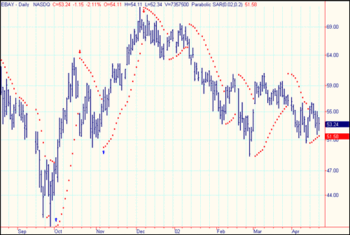- Parabolic SAR
-
In the field of technical analysis, Parabolic SAR (SAR - stop and reverse) is a method devised by J. Welles Wilder, Jr., to find trends in market prices or securities. It may be used as a trailing stop loss based on prices tending to stay within a parabolic curve during a strong trend.
The concept draws on the idea that time is the enemy (similar to option theory's concept of time decay), and unless a security can continue to generate more profits over time, it should be liquidated. The indicator generally works well in trending markets, but provides "whipsaws" during non-trending, sideways phases; as such, Wilder recommended establishing the strength and direction of the trend first through the use of things such as the Average Directional Index, and then using the Parabolic SAR to trade that trend.
A parabola below the price is generally bullish, while a parabola above is generally bearish.
Construction
The Parabolic SAR is calculated almost independently for each trend in the price. When the price is in an uptrend, the SAR appears below the price and converges upwards towards it. Similarly, on a downtrend, the SAR appears above the price and converges downwards.
At each step within a trend, the SAR is calculated ahead of time. That is, tomorrow's SAR value is built using data available today. The general formula used for this is:
Where SARn and SARn + 1 represent today's and tomorrow's SAR values, respectively.
The extreme point, EP, is a record kept during each trend that represents the highest value reached by the price during the current uptrend — or lowest value during a downtrend. On each period, if a new maximum (or minimum) is observed, the EP is updated with that value.
The α value represents the acceleration factor. Usually, this is set to a value of 0.02 initially. This factor is increased by 0.02 each time a new EP is recorded. In other words, each time a new EP is observed, it will increase the acceleration factor. This will then quicken the rate at which the SAR converges towards the price. To keep it from getting too large, a maximum value for the acceleration factor is normally set at 0.20, so that it never goes beyond that. For stocks trading, it is preferable to set the acceleration factor to 0.01, in order to be less sensitive to local decreases. For commodity or currency trading, it is preferable to use a value of 0.02.
The SAR is iteratively calculated for each new period using this recursive definition. There are, however, two special cases that will modify the SAR value:
- If tomorrow's SAR value lies within (or beyond) today's or yesterday's price range, the SAR must be set to the closest price bound. For example, if in an uptrend, the new SAR value is calculated and it results to be greater than today's or yesterday's lowest price, the SAR must be set equal to that lower boundary.
- If tomorrow's SAR value lies within (or beyond) tomorrow's price range, a new trend direction is then signaled, and the SAR must "switch sides."
Upon a trend switch, several things happen. The first SAR value for this new trend is set to the last EP recorded on the previous trend. The EP is then reset accordingly to this period's maximum. The acceleration factor is reset to its initial value of 0.02.
External links
References
- J. Welles Wilder, Jr. (June 1978). New Concepts in Technical Trading Systems. Greensboro, NC: Trend Research. ISBN 978-0894590276.
Concepts Support and resistance · Trend line · Breakout · Market trend · Dead cat bounce · Elliott wave principle · Fibonacci retracements · Pivot point · Dow theoryCharts Patterns Head and shoulders · Cup and handle · Double top and double bottom · Triple top and triple bottom · Broadening top · Price channels · Wedge pattern · Triangle · Flag and pennant · Island reversal · GapCandlestickSimpleComplexIndicators Average Directional Index (ADX) · Ichimoku Kinkō Hyō · Moving Average Convergence/Divergence (MACD) · Mass Index · Moving average (MA) · Parabolic SAR (SAR) · Smart Money Index (SMI) · Trix · Vortex Indicator (VI) · Know sure thing oscillator (KST)Relative Strength Index (RSI) · Stochastic oscillator · True Strength Index (TSI) · Williams %R (%R)VolumeAccumulation/Distribution Index · Money Flow Index (MFI) · On-balance volume (OBV) · Volume Price Trend (VPT) · Force Index (FI) · Negative volume index (NVI) · Ease of movement · Put/call ratio (PCR)OtherAdvance–decline line (ADL) · Commodity Channel Index (CCI) · Coppock curve · Keltner channel · McClellan oscillator · Ulcer Index · Ultimate oscillatorCategories:- Chart overlays
Wikimedia Foundation. 2010.


